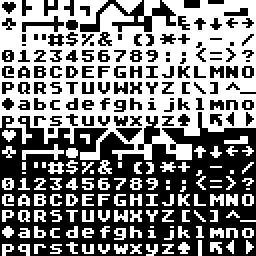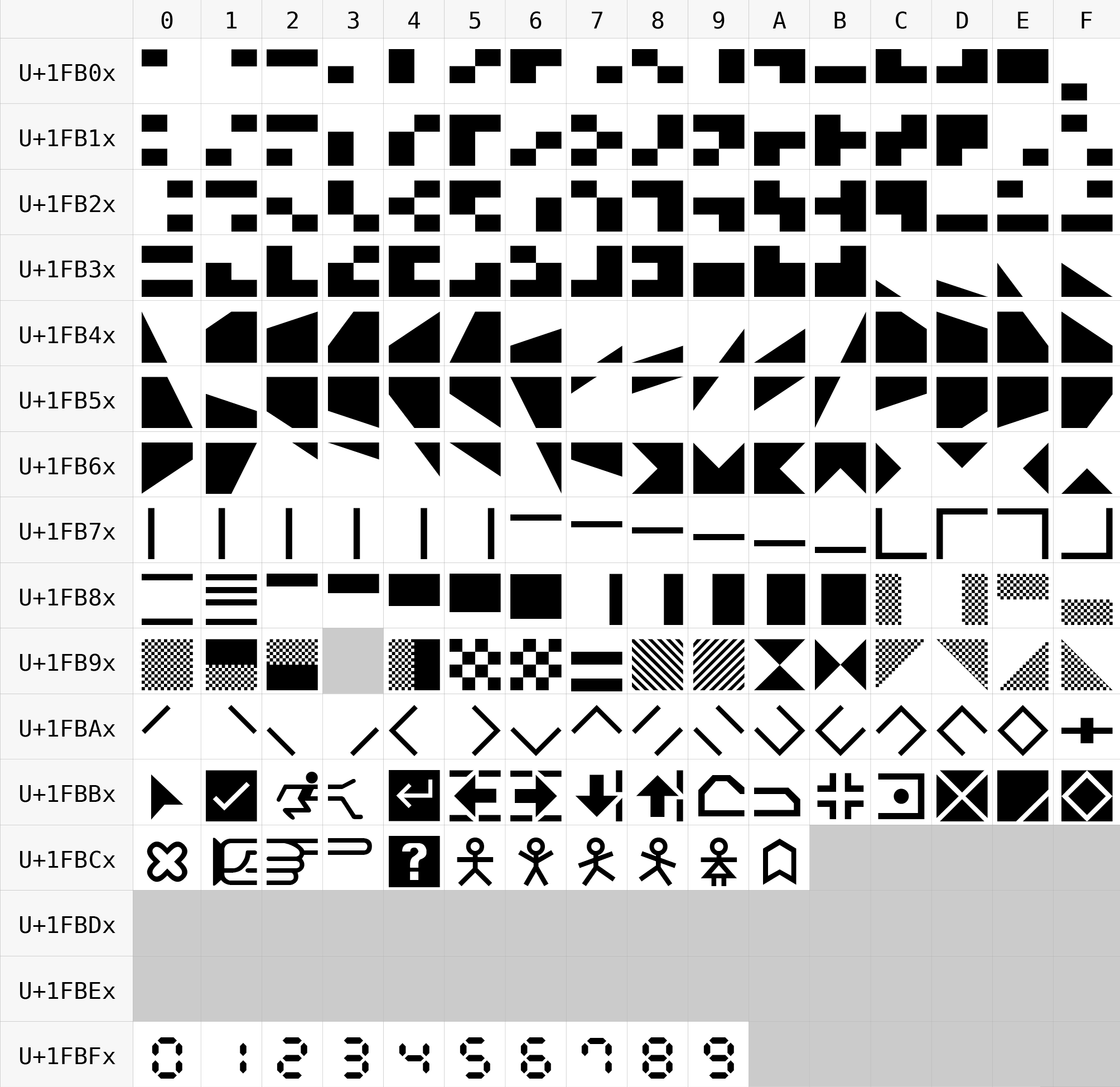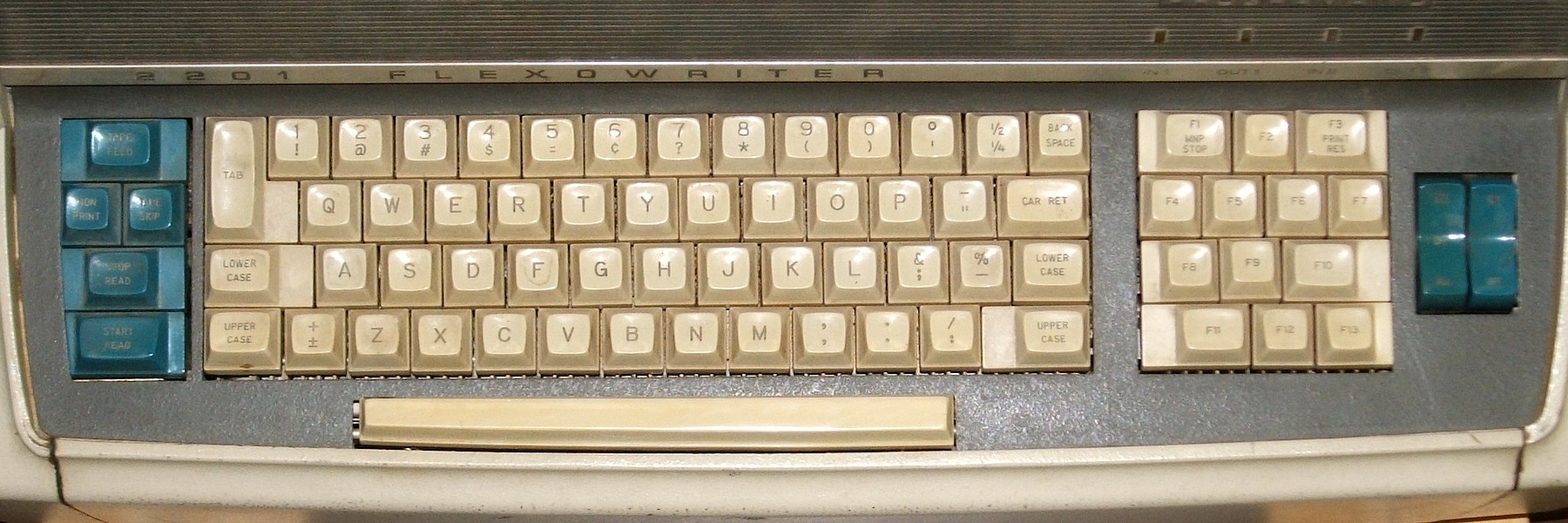|
ATASCII
The ATASCII character set, from ''ATARI Standard Code for Information Interchange'', alternatively ''ATARI ASCII'', is a character encoding used in the Atari 8-bit computers. ATASCII is based on ASCII, but is not fully compatible with it. It was first used in the Atari 400 and 800 in 1979 and was kept in all subsequent models until the line was discontinued in 1992. The Atari ST family of computers use the different Atari ST character set. Like most other variants of ASCII, ATASCII has its own distinct characters (arrows, blocks, box-drawing characters, playing card suits, etc.) in place of the C0 control codes in ASCII (characters 0โ31), as well as replacing a few other ASCII code points. Implementation Atari 8-bit systems have three distinct sets of codes: interchange codes (ATASCII), internal codes (also called screen codes), and keyboard codes. Keyboard codes represent the codes sent by the keyboard. Pressing one of the two modifier keys ( Shift and Control) modifies the ... [...More Info...] [...Related Items...] OR: [Wikipedia] [Google] [Baidu] |
Atari BASIC
Atari BASIC is an interpreter for the BASIC programming language that shipped with Atari 8-bit computers. Unlike most American BASICs of the home computer era, Atari BASIC is not a derivative of Microsoft BASIC and differs in significant ways. It includes keywords for Atari-specific features and lacks support for string arrays. The language was distributed as an 8 KB ROM cartridge for use with the 1979 Atari 400 and 800 computers and included the ''Atari BASIC Reference Manual'' written by Carol Shaw and Keith Brewster. Starting with the 600XL and 800XL in 1983, BASIC is built into the system. There are three primary versions of the software: the original cartridge-based "A", the built-in "B" for the 600XL/800XL, and the final "C" version in late-model XLs and the XE series. Despite the Atari 8-bit computers running at a higher speed than most of its contemporaries, several technical decisions placed Atari BASIC near the bottom in performance benchmarks. The original ... [...More Info...] [...Related Items...] OR: [Wikipedia] [Google] [Baidu] |
๐ฎ
Symbols for Legacy Computing is a Unicode block containing graphic characters that were used for various home computers from the 1970s and 1980s and in teletext broadcasting standards. It includes characters from the Amstrad CPC, MSX, Mattel Aquarius, RISC OS, MouseText, Atari ST, TRS-80 Color Computer, Oric, Texas Instruments TI-99/4A, TRS-80, Minitel, Teletext, ATASCII, PETSCII, ZX80, and ZX81 character sets. Semigraphics characters are also included in the form of new block-shaped characters, line-drawing characters, and 60 "sextant" characters (semigraphic character made up of six smaller blocks). Additional characters were added to this block in Unicode 16.0 as well. A supplemental block (Symbols for Legacy Computing Supplement) was added with Unicode 16.0. Block The image below is provided as quick reference for these symbols on systems that are unable to display them directly (although it lacks code points newly assigned in Unicode 16.0): History The following Uni ... [...More Info...] [...Related Items...] OR: [Wikipedia] [Google] [Baidu] |
ASCII
ASCII ( ), an acronym for American Standard Code for Information Interchange, is a character encoding standard for representing a particular set of 95 (English language focused) printable character, printable and 33 control character, control characters a total of 128 code points. The set of available punctuation had significant impact on the syntax of computer languages and text markup. ASCII hugely influenced the design of character sets used by modern computers; for example, the first 128 code points of Unicode are the same as ASCII. ASCII encodes each code-point as a value from 0 to 127 storable as a seven-bit integer. Ninety-five code-points are printable, including digits ''0'' to ''9'', lowercase letters ''a'' to ''z'', uppercase letters ''A'' to ''Z'', and commonly used punctuation symbols. For example, the letter is represented as 105 (decimal). Also, ASCII specifies 33 non-printing control codes which originated with ; most of which are now obsolete. The control cha ... [...More Info...] [...Related Items...] OR: [Wikipedia] [Google] [Baidu] |
๐ฎ
Symbols for Legacy Computing is a Unicode block containing graphic characters that were used for various home computers from the 1970s and 1980s and in teletext broadcasting standards. It includes characters from the Amstrad CPC, MSX, Mattel Aquarius, RISC OS, MouseText, Atari ST, TRS-80 Color Computer, Oric, Texas Instruments TI-99/4A, TRS-80, Minitel, Teletext, ATASCII, PETSCII, ZX80, and ZX81 character sets. Semigraphics characters are also included in the form of new block-shaped characters, line-drawing characters, and 60 "sextant" characters (semigraphic character made up of six smaller blocks). Additional characters were added to this block in Unicode 16.0 as well. A supplemental block ( Symbols for Legacy Computing Supplement) was added with Unicode 16.0. Block The image below is provided as quick reference for these symbols on systems that are unable to display them directly (although it lacks code points newly assigned in Unicode 16.0): History The following ... [...More Info...] [...Related Items...] OR: [Wikipedia] [Google] [Baidu] |
Atari ST Character Set
The Atari ST character set is the character set of the Atari ST personal computer family including the Atari STE, TT and Falcon. It is based on code page 437, the original character set of the IBM PC. Like codepage 437, it aligns with ASCII codepoints 32โ126, and has additional codepoints including letters with diacritics and other symbols. It differs from code page 437 in using other dingbats at code points 0โ31, in exchanging the box-drawing characters 176โ223 for the Hebrew alphabet and other symbols, and exchanging code points 158, 236 and 254โ255 with the symbols for sharp S, line integral, cubed and macron. The Atari ST family of computers contained this font stored in ROM in three sizes; as an 8ร16 pixels-per-character font used in the high-resolution graphics modes, as an 8ร8 pixels-per-character font used in the low- and medium-resolution graphics modes, and as a 6ร6 pixels-per-character font used for icon labels in any graphics mode. All 256 codes were as ... [...More Info...] [...Related Items...] OR: [Wikipedia] [Google] [Baidu] |
Atari 1200XL
The Atari 8-bit computers, formally launched as the Atari Home Computer System, are a series of home computers introduced by Atari, Inc., in 1979 with the Atari 400 and Atari 800. The architecture is designed around the 8-bit MOS Technology 6502 CPU and three custom coprocessors which provide support for sprites, smooth multidirectional scrolling, four channels of audio, and other features. The graphics and sound are more advanced than most of its contemporaries, and video games are a key part of the software library. The 1980 first-person space combat simulator ''Star Raiders'' is considered the platform's killer app. The Atari 800 was positioned as a high-end model and the 400 as more affordable. The 400 has a pressure-sensitive, spillproof membrane keyboard and initially shipped with a non-upgradable of RAM. The 800 has a conventional keyboard, a second cartridge slot, and allows easy RAM upgrades to 48K. Both use identical 6502 CPUs at ( for PAL versions) and coprocessors ... [...More Info...] [...Related Items...] OR: [Wikipedia] [Google] [Baidu] |
Function Key
A function key is a key on a computer or computer terminal, terminal computer keyboard, keyboard that can be programmed to cause the operating system or an application program to perform certain actions, a form of soft key. On some keyboards/computers, function keys may have default actions, accessible on power-on. Function keys on a terminal may either generate short fixed sequences of characters, often beginning with the escape character (ASCII 27), or the characters they generate may be configured by sending special character sequences to the terminal. On a standard computer keyboard, the function keys may generate a fixed, single byte code, outside the normal ASCII range, which is translated into some other configurable sequence by the keyboard device driver or interpreted directly by the application program. Function keys may have abbreviations or pictographic representations of default actions printed on/besides them, or they may have the more common "F-number" designatio ... [...More Info...] [...Related Items...] OR: [Wikipedia] [Google] [Baidu] |
PEEK And POKE
In computing, PEEK and POKE are commands used in some high-level programming languages for accessing the contents of a specific Memory cell (computing), memory cell referenced by its memory address. PEEK gets the byte located at the specified memory address. POKE sets the memory byte at the specified address. These commands originated with machine code monitors such as the PDP-10, DECsystem-10 monitor; these commands are particularly associated with the BASIC programming language, though some other languages such as Pascal (programming language), Pascal and COMAL (programming language), COMAL also have these commands. These commands are comparable in their roles to Pointer (computer programming), pointers in the C (programming language), C language and some other programming languages. One of the earliest references to these commands in BASIC, if not the earliest, is in Altair BASIC. The PEEK and POKE commands were conceived in early personal computing systems to serve a variet ... [...More Info...] [...Related Items...] OR: [Wikipedia] [Google] [Baidu] |
BASIC
Basic or BASIC may refer to: Science and technology * BASIC, a computer programming language * Basic (chemistry), having the properties of a base * Basic access authentication, in HTTP Entertainment * Basic (film), ''Basic'' (film), a 2003 film * Basic, one of the Galactic Basic, languages in ''Star Wars'' Music * Basic (Glen Campbell album), ''Basic'' (Glen Campbell album), 1978 * Basic (Robert Quine and Fred Maher album), ''Basic'' (Robert Quine and Fred Maher album), 1984 * B.A.S.I.C. (Alpinestars album), ''B.A.S.I.C.'' (Alpinestars album), 2000 * Basic (Brown Eyed Girls album), ''Basic'' (Brown Eyed Girls album), 2015 * B.A.S.I.C. (The Basics album), ''B.A.S.I.C.'' (The Basics album), 2019 Places * Basic, Mississippi, a community in the US * BASIC countries, Brazil, South Africa, India and China in climate change negotiations Organizations * BASIC Bank Limited, government owned bank in Bangladesh * Basic Books, an American publisher Other uses * Basic (cigarette), a brand ... [...More Info...] [...Related Items...] OR: [Wikipedia] [Google] [Baidu] |
Control Character
In computing and telecommunications, a control character or non-printing character (NPC) is a code point in a character encoding, character set that does not represent a written Character (computing), character or symbol. They are used as in-band signaling to cause effects other than the addition of a symbol to the text. All other characters are mainly ''graphic characters'', also known as ''printing characters'' (or ''printable characters''), except perhaps for "space (punctuation), space" characters. In the ASCII standard there are 33 control characters, such as code 7, , which rings a terminal bell. History Prosigns for Morse code, Procedural signs in Morse code are a form of control character. A form of control characters were introduced in the 1870 Baudot code: NUL and DEL. The 1901 Murray code added the carriage return (CR) and line feed (LF), and other versions of the Baudot code included other control characters. The bell character (BEL), which rang a bell to alert op ... [...More Info...] [...Related Items...] OR: [Wikipedia] [Google] [Baidu] |
Eastern Europe
Eastern Europe is a subregion of the Europe, European continent. As a largely ambiguous term, it has a wide range of geopolitical, geographical, ethnic, cultural and socio-economic connotations. Its eastern boundary is marked by the Ural Mountains, and its western boundary is defined in various ways. Narrow definitions, in which Central Europe, Central and Southeast Europe are counted as separate regions, include Belarus, Russia and Ukraine. In contrast, broader definitions include Moldova and Romania, but also some or all of the Balkans, the Baltic states, the Caucasus, and the Visegrรกd Group, Visegrรกd group. The region represents a significant part of Culture of Europe, European culture; the main socio-cultural characteristics of Eastern Europe have historically largely been defined by the traditions of the Slavs, as well as by the influence of Eastern Christianity as it developed through the Byzantine Empire, Eastern Roman Empire and the Ottoman Empire. Another definition was ... [...More Info...] [...Related Items...] OR: [Wikipedia] [Google] [Baidu] |






